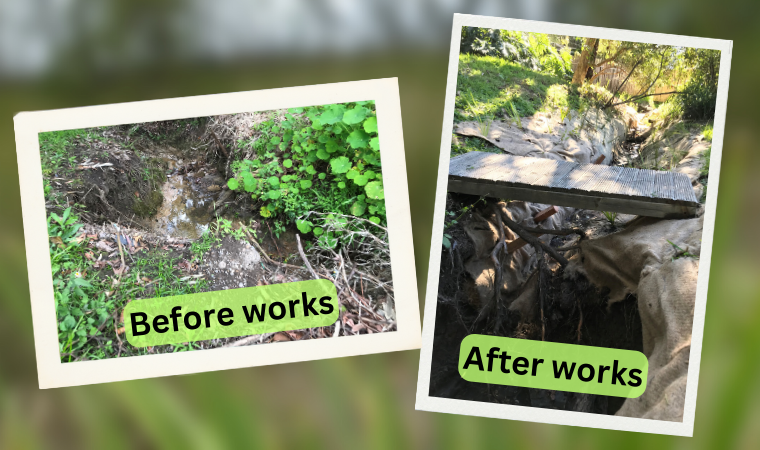Fridays in the Field with Simon, Landcare Projects Delivery Officer
Published on 04 July 2024

Recently, some rehabilitation work was carried out on an ephemeral creek at the Kullaroo Road Landcare site. The creekline was suffering; a knick point was developing in the creek bed, the banks were slumping causing sedimentation and the creekbanks were collapsing. Native vegetation was absent from the creek and there was little in the way of habitat. With no intervention, the creekline would continue to degrade, eroding away the banks causing loss of topsoil and damage to downstream biodiversity.
The Landcarer was determined to make a positive difference to the natural area behind her house, and the creekline is the start of the ongoing rehabilitation. Erosion starts from the top of the creek, so that’s where our efforts started. Slotted jute matting, a carpet-like natural product, was laid out along the length of the creekline and up the banks. This created a temporary impervious layer that stopped moving water washing away the banks, repressed weed growth, and allowed native tubestock to be planted in the ‘slots’. Eventually the jute breaks down, but by that time plant roots have been given a chance to stabilise the soil.
Where banks had been undercut, Coco-fibre logs were placed. This prevents further erosion and allows sediment and organic debris to collect. One log was placed across the creek as a ‘leaky weir’. Leaky weirs slow the flow of water, catch sediment and debris, and encourage pooling. With some reintroduction of native species such as Lomandra, Juncus, Hypolepsis, Carex and Persicaria, a creekline with a wide array of habitats is being encouraged. All of these plant species will spread their roots quickly, provide habitat and importantly, lay over during high flows of water. There is a balance in urban creeks between habitat creation and adequate drainage.
Timber is also an important component of creek restoration. Following the adage of ‘a messy creek is a good creek’, timber logs have been reintroduced to the streambank. Timber works in a number of ways to recreate vibrant habitat and a healthy stream. Timber is the reinforcement of a streambank encouraging sediment bars, slowing down water flow, and providing habitat for insects, invertebrates and frogs. It also redirects water away from banks, gathers sediment around itself and gives riparian vegetation an important anchor. Some careful placement of rocks around the knick point area was used as way of preventing further degradation and a redistribution of water flows.
The creekline will now work as the ‘best bit’ of the site where further restoration activities will move out from. There are still some native canopy species present onsite, but a lot of targeted weeding will need to be carried out to give the natural area the best chance of rehabilitation. Creek restoration is a process, so we will need to revisit regularly to see how our controls are progressing.